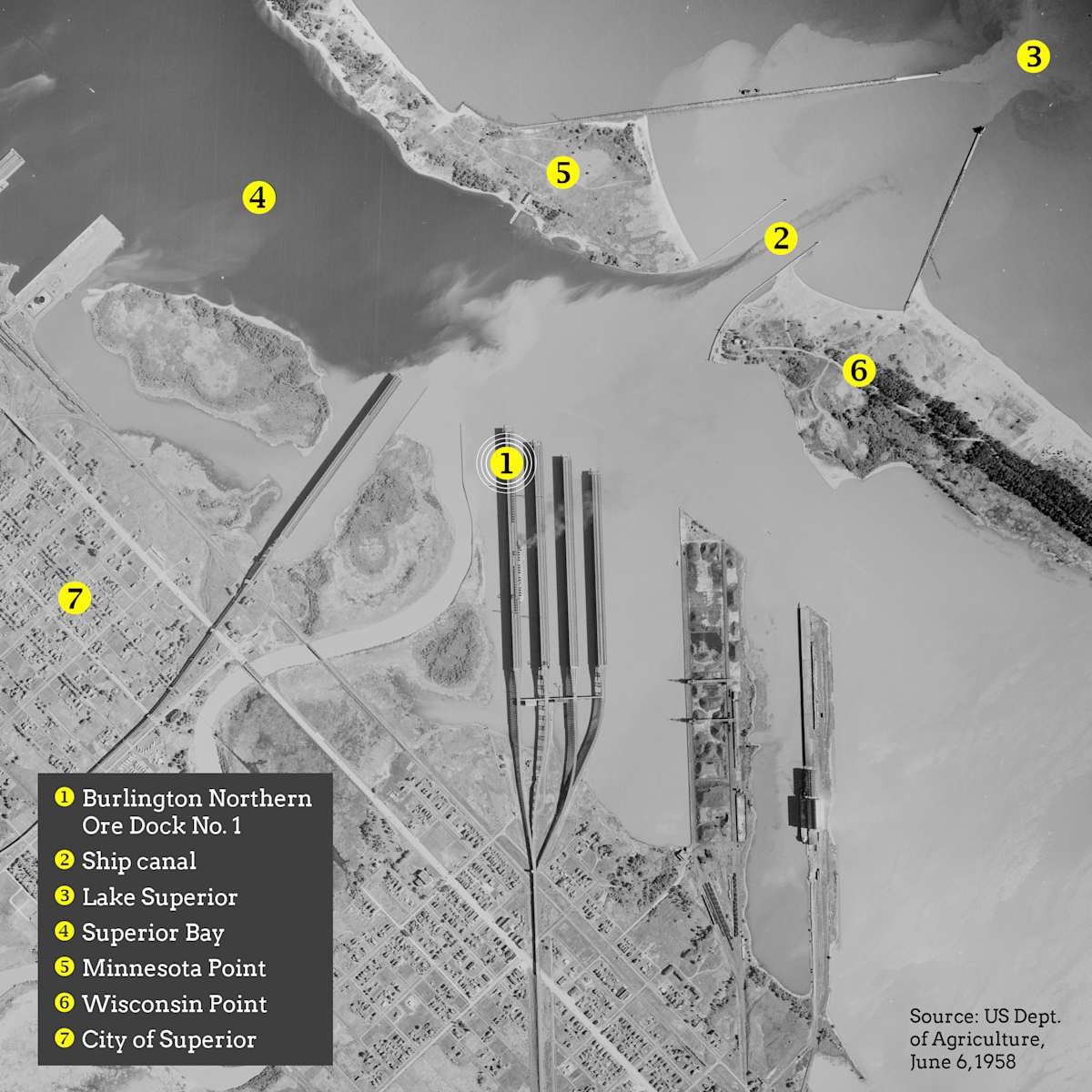Unless you live in one of the state’s coastal communities, it can be easy to forget that Wisconsin has strong maritime traditions. It borders two of the Great Lakes, Superior and Michigan, that combined hold almost fifteen percent of the world’s fresh water. Lake Superior is the largest lake on earth by area. It is also very deep – over 1,300 feet – and very cold. [1]
Since the beginning of European settlement of the upper Midwest, Lake Superior has been a commercial shipping lane for iron ore, lumber, grain and other commodities. Among the first commercial freighters were wooden schooners, later replaced by metal-hulled ships powered by steam or diesel engines. Lake Superior’s angry weather has sunk hundreds of these vessels. But the most well-known of these, without a doubt, is the SS Edmund Fitzgerald, which sank in Lake Superior fifty years ago on November 10, 1975.
At the time of its sinking, the Edmund Fitzgerald was considered one of the best iron ore carriers in operation. It was a modern, well-engineered ship, built only seventeen years earlier. And it had a long list of records to its credit – most ore carried in a single season, most on a single voyage and most through the Soo Locks at Sault Ste. Marie. [2] The sinking of such a prominent ship came as a shock to many.
The Edmund Fitzgerald sank in Canadian waters near the Shipwreck Coast along Michigan’s Upper Peninsula, a graveyard of wrecked vessels. The waves on the night of November 10, 1975, were reportedly thirty feet high and winds were gusting to 80 miles per hour. Before going down, Captain McSorley of the Edmund Fitzgerald reported by radio, “Big sea – I’ve never seen anything like it in my life.” [3]
The ship had taken on water through several broken ventilator covers and was listing by mid-afternoon on that fateful Monday. It was being trailed by another ore carrier, the Arthur M. Anderson, which was keeping a close eye on the Edmund Fitzgerald because its navigation equipment had failed. As the Edmund Fitzgerald rode over the high waves, it kept disappearing and reappearing. But then, at about 7 pm, it suddenly vanished. It was only fifteen miles from the calmer waters of Whitefish Bay.
The Edmund Fitzgerald was a Wisconsin ship. Owned by the Northwestern Mutual Life Insurance Company and named after its President, its home port was Milwaukee. The ship was built in Detroit in 1958 and, at that time, it was the biggest object ever launched into fresh water. [4] At 729 feet, it was one foot shorter than the maximum length permitted by the US Army Corps of Engineers to pass through the Soo Locks. The Titanic, which carried over 2,200 people on its maiden (and final) voyage, was only 150 feet longer. The length of the Edmund Fitzgerald exceeds the height of the tallest building in Wisconsin, the US Bank Center, by almost 130 feet.
When it left Burlington Northern Ore Dock No. 1 in Superior on November 9, bound for Detroit, the Edmund Fitzgerald was carrying slightly more than 26,000 long tons of taconite (iron ore that has been heated and rolled into marble-sized balls for more efficient shipping). That’s equivalent to over 58 million pounds, just shy of the combined weight of every inhabitant of Green Bay, Manitowoc, Sheboygan, Kenosha and Racine. [5]
All twenty-nine of the Edmund Fitzgerald’s crew were lost with the ship. They ranged in age from twenty to over sixty, Captain McSorley being the oldest. Most were born in Great Lakes states, including eight from Wisconsin. Most were seasoned sailors. McSorley had worked on ocean and lake freighters since the age of eighteen and was approaching his retirement.
Unlike the Titanic, which took over two and a half hours to sink, the Edmund Fitzgerald went down so quickly that the crew had no time to lower lifeboats. And even if they did, it’s doubtful they would have survived the waves.
The wreck was located a few days later by a Navy airplane equipped to detect magnetic anomalies. It lies today, broken in two, in over 500 feet of water. In 1976, a Navy underwater recovery vehicle photographed the wreck to verify its identity. The words, “Edmund Fitzgerald, Milwaukee” were visible on its stern. [6]
There have been many other shipwrecks in Lake Superior, including other ore carriers, and some of these caused even greater loss of life. That’s not to say that the Edmund Fitzgerald wasn’t a tragedy, but rather emphasize the perils of sailing the waters of Lake Superior, especially during one of its infamous fall storms.
In the meantime, we can reflect on the human costs behind the things we often take for granted – like the steel used to make bridges, buildings, automobiles, home appliances and even kitchen cutlery.
The Great Lakes Shipwreck Historical Society is holding a public remembrance service for the fiftieth anniversary at Whitefish Point on Monday Nov 10, 2025, at 2 pm. [7]
Sources and Notes:
[1] Great Lakes Commission, About the Lakes. https://www.glc.org/lakes
[2] William Ratigan, Great Lakes Shipwrecks and Survivals. Grand Rapids, MI: Wm. B. Eerdmans Publishing, 1977, p. 316.
[3] Ratigan, p. 323.
[4] Ratigan, p. 315.
[5] This estimate is based on an average weight per person of 162 pounds, using the population age distribution of Wisconsin from the Census Bureau and average weights by age group from the National Center for Health Statistics. https://censusreporter.org/profiles/04000US55-wisconsin
https://www.cdc.gov/nchs/data/series/sr_03/sr03-046-508.pdf
[6] Great Lakes Shipwreck Museum. https://shipwreckmuseum.com/the-fateful-journey
[7] Great Lakes Shipwreck Museum. https://shipwreckmuseum.com/edmund-fitzgerald-memorial-ceremonies-on-november-10-2025
